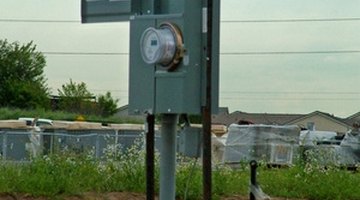How to Install a 20 Amp Gfci Circuit Breaker
A GFCI circuit breaker offers protection for home electric users by breaking a circuit to cut power if a ground fault, or voltage leak, occurs anywhere in the electrical wiring. A common breaker switch protects only circuits and appliances. The GFCI breaker switch is connected to the neutral wire as well as the hot wire to allow it to monitor the current flow through both. A ground fault is detected if the current through both wires does not remain even. Make the electrical wiring safer in your home with GFCI circuit breakers.

-
Check local electrical codes for specifications on wire gauge. Most codes demand 12-gauge wire for 20 amp circuits. Some local codes require licensed electricians to perform household electrical wiring.
-
Locate the breaker switch to be replaced by plugging a radio into an outlet on the circuit and turning it on. Flip individual breaker switches until the radio sound goes off. The breaker switch that shuts off the radio is the switch to replace.
-
Shut off the main power switch at the breaker panel. Use a flashlight if the room holding the breaker panel is darkened with the power off. Open the panel door and remove the holding screws on the panel cover and take it off the box. The thicker wires that are secured to the upper panel terminals are still carrying live electricity. Do not touch these wires or terminals with your bare hands or metal tools.
-
Check the wire gauge on an existing circuit if installing a replacement breaker. Use a wire gauge measuring tool to be sure the wire is 12 gauge. Some codes allow, or formerly allowed, 14-gauge wire for 15 amp breakers on 120-volt circuits. Install a 12/2 Romex cable to replace 14-gauge electrical wiring in an old circuit.
-
Remove the old breaker to replace it with a new 20 amp GFCI switch. Pull the switch out of the panel. It simply plugs in at one end with two prongs, and clips onto a holding bar at the other end. Unscrew the terminal holding the black, or red hot, wire with a Phillips-head screwdriver. Trace the hot wire back to the cable entrance in the breaker box. Then trace the white neutral wire from that cable to the neutral bus bar. Loosen the terminal holding that neutral wire with a slotted screwdriver and pull out the wire. Leave the ground wire from that cable attached to the ground bus bar.
-
Clip the ends off old wires that were connected to terminals with wire cutters. Strip 5/8 of an inch of insulation off to expose fresh wire for connections. Strip the new wires for connection if replacing the wiring.
-
Connect the wires to the 20 amp GFCI switch. Slip the hot wire from the old switch, or the new hot wire from the Romex, into the clamp terminal labeled "Line power" on the GFCI switch. Tighten the terminal firmly. Feed the white neutral wire into the terminal labeled "Load neutral," and tighten the terminal screw firmly. Secure the coiled white wire from the GFCI switch to the ground bus bar and tighten that terminal firmly.
-
Put the bare copper ground wire from a replacement Romex cable into a free terminal on the ground bus bar holding the copper and green wires. Tighten the ground terminal with a torque wrench and screwdriver attachment. Set the torque for the specification listed on the breaker panel.
-
Set the switch on the new 20 amp GFCI breaker to the off position before placing it into the panel. Connect the clip side to the holding bar first, than push the plug prongs into the power ports. Put the cover back over the panel and replace the holding screws.
-
Turn on the main power switch and test the new breaker. Turn the radio or light back on in the circuit. Flip the GFCI switch on and the radio should begin playing. Push the "Test" button on the switch and the sound should go off. Reset the switch by flipping it to the off position and back on.
References
Warnings
- Never perform wiring jobs in a home unless you have training or experience in electrical work.
- Do not work on an open breaker panel unless you are comfortable around live electricity.
- Be exceptionally cautious not to contact the incoming hot wires on the breaker panel with metal or body parts. Fire, damage and serious injury can result from contacting these lines, which carry over 240 volts.
Writer Bio
Jonra Springs began writing in 1989. He writes fiction for children and adults and draws on experiences in education, insurance, construction, aviation mechanics and entertainment to create content for various websites. Springs studied liberal arts and computer science at the College of Charleston and Trident Technical College.
Photo Credits
- electric box, image by Greg Pickens from Fotolia.com
More Articles



